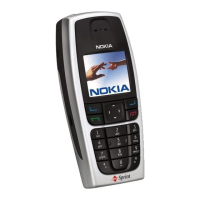Section 4A: Safety Guidelines 123
Getting the Most Out of Your Reception
Keeping Tabs on Signal Strength
The quality of each call you make or receive depends on the signal strength in your
area. Your phone informs you of the current signal strength by displaying a number of
bars next to the signal strength icon. The more bars displayed, the stronger the signal.
If you’re inside a building, being near a window may give you better reception.
Understanding the Power Save Feature
If your phone is unable to find a signal after 15 minutes of searching, a Power Save
feature is automatically activated. If your phone is active, it periodically rechecks
service availability; you can also check it yourself by pressing any key. Anytime the
Power Save feature is activated, a message is displayed on the screen. When a signal is
found, your phone returns to standby mode.
Understanding How Your Phone Operates
Your phone is basically a radio transmitter and receiver. When it’s turned on, it
receives and transmits radiofrequency (RF) signals. When you use your phone, the
system handling your call controls the power level. This power can range from
0.00001 watts to 0.373 watts in digital mode, depending upon in which band your
phone operates.
Knowing Radiofrequency Safety
The design of your Sprint PCS Voice Phone complies with updated NCRP standards
described below.
In 1991-92, the Institute of Electrical and Electronics Engineers (IEEE) and the
American National Standards Institute (ANSI) joined in updating ANSI’s 1982 standard
for safety levels with respect to human exposure to RF signals. More than 120
scientists, engineers and physicians from universities, government health agencies
and industries developed this updated standard after reviewing the available body of
research. In 1993, the Federal Communications Commission (FCC) adopted this
updated standard in a regulation. In August 1996, the FCC adopted hybrid standard
consisting of the existing ANSI/IEEE standard and the guidelines published by the
National Council of Radiation Protection and Measurements (NCRP).
Maintaining Your Phone’s Peak Performance
There are several simple guidelines to operating your phone properly and maintaining
safe, satisfactory service.
䢇 Speak directly into the mouthpiece.
䢇 Avoid exposing your phone and accessories to rain or liquid spills. If your
phone does get wet, immediately turn the power off, remove the battery, and
dry thoroughly.
䢇 For optimal performance, store and use your phone between a temperature
range of 23ºF and 140ºF (-5ºC and 60ºC).
䢇 Do not use or store your phone in dusty, dirty areas. Its moving parts and
electronic components can be damaged.
䢇 Do not attempt to open your phone other than as instructed in this guide.
䢇 Do not drop, knock or shake your phone. Rough handling can break internal
circuit boards and fine mechanics.
䢇 Do not use harsh chemicals, cleaning solvents, or strong detergents to clean your
phone.

